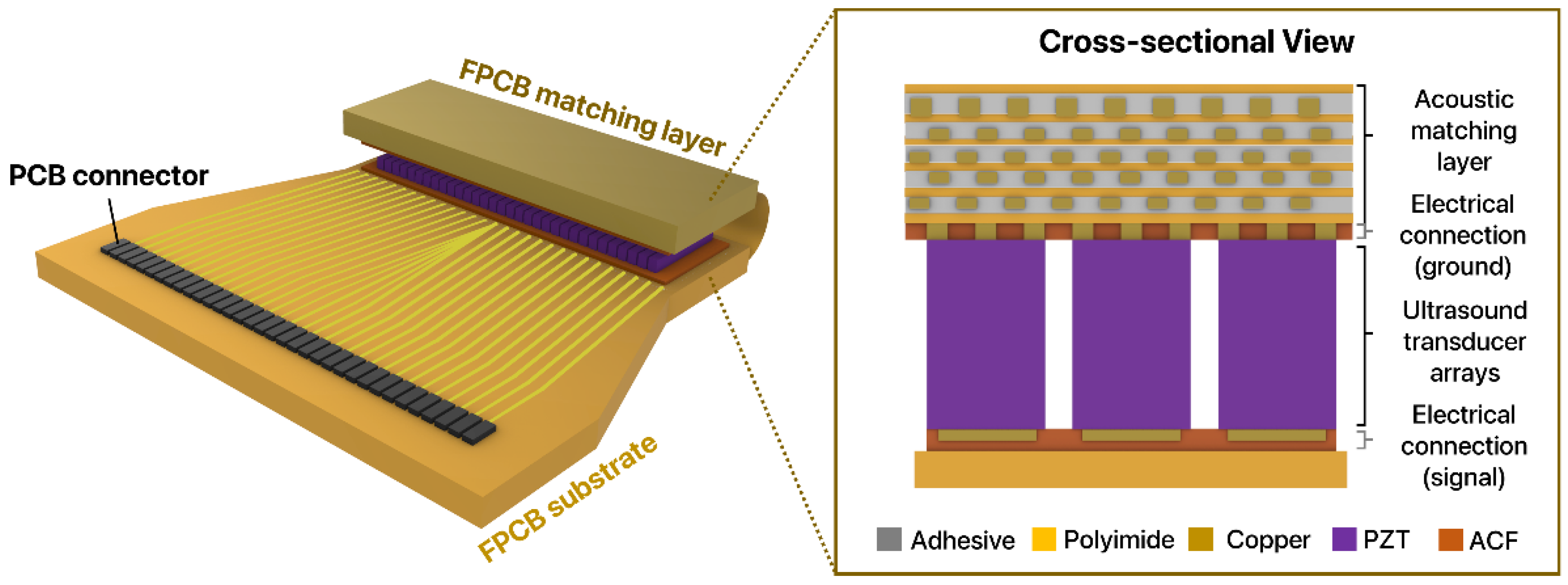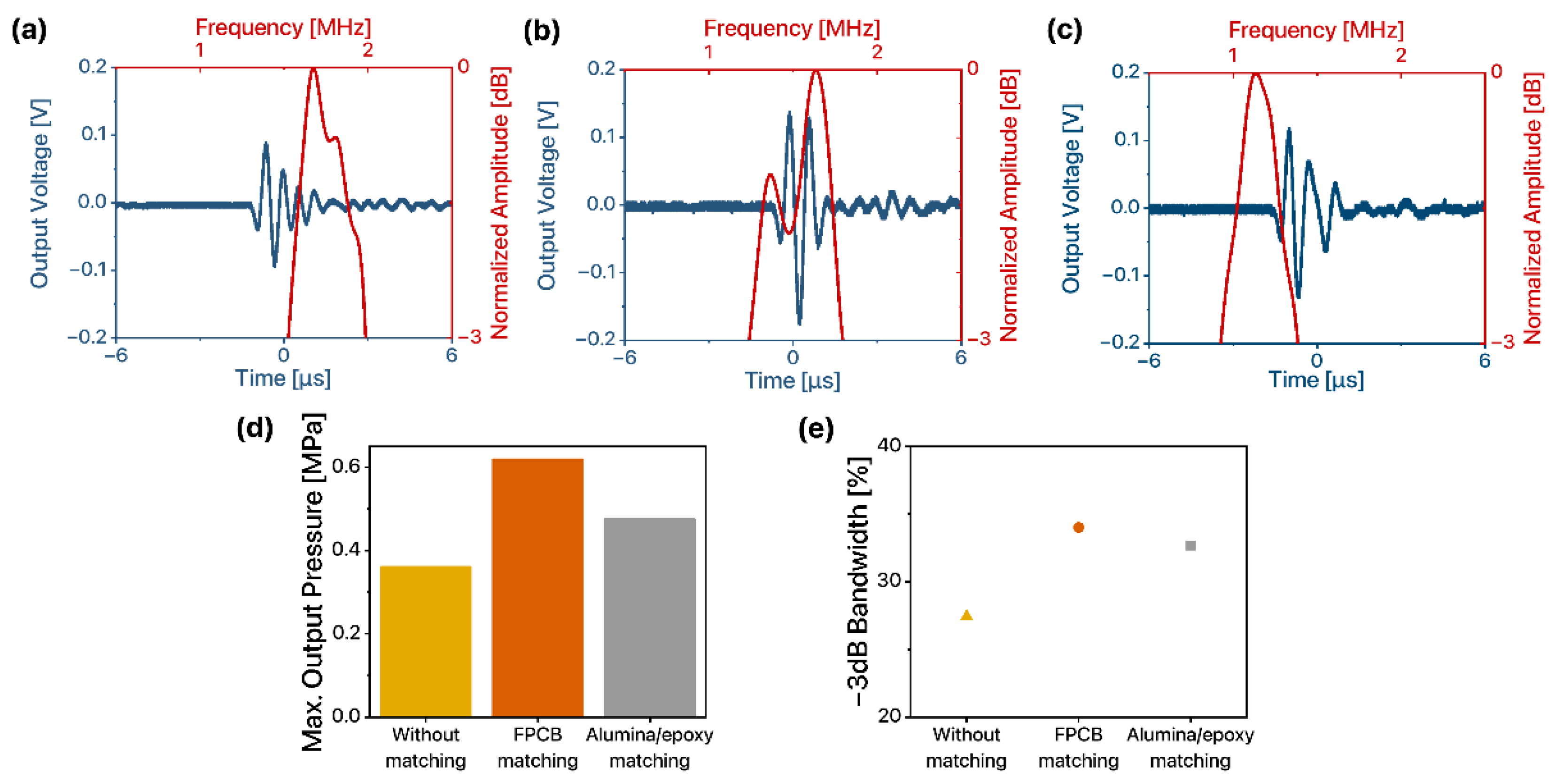FPCB as an Acoustic Matching Layer for 1D Linear Ultrasound Transducer Arrays
Abstract
:1. Introduction
2. Materials and Methods
2.1. Design and Fabrication of the FPCB Matching Layer
2.2. Fabrication of the Alumina/Epoxy Matching Layer
2.3. Acoustic Property Measurement of Matching Layers
2.4. Fabrication of the 1D Linear Ultrasound Transducer Array with the FPCB Matching Layer
2.5. Thickness Uniformity Measurement of 1D Linear Ultrasound Transducer Arrays
2.6. Electrical Characterization of 1D Linear Ultrasound Transducer Arrays
2.7. Acoustic Characterization of 1D Linear Ultrasound Transducer Arrays
3. Results
3.1. Acoustic Properties of the FPCB Matching Layer
3.2. Physical Characteristics of 1D Linear Ultrasound Transducer Arrays
3.3. Electrical Characterization of 1D Linear Ultrasound Transducer Arrays
3.4. Acoustic Properties of 1D Linear Ultrasound Transducer Arrays
3.4.1. Output Pressure and Bandwidth
3.4.2. Ultrasound Beam Profile
4. Conclusions
Supplementary Materials
Author Contributions
Funding
Institutional Review Board Statement
Informed Consent Statement
Data Availability Statement
Conflicts of Interest
References
- Lee, W.; Roh, Y. Ultrasonic transducers for medical diagnostic imaging. Biomed. Eng. Lett. 2017, 7, 91–97. [Google Scholar] [CrossRef]
- Zhang, R.; Cao, W.; Zhou, Q.; Cha, J.H.; Shung, K.K.; Huang, Y. Acoustic properties of alumina colloidal/polymer nano-composite film on silicon. IEEE Trans. Ultrason. Ferroelectr. Freq. Control. 2007, 54, 467–469. [Google Scholar] [CrossRef]
- Rathod, V.T. A Review of Acoustic Impedance Matching Techniques for Piezoelectric Sensors and Transducers. Sensors 2020, 20, 4051. [Google Scholar] [CrossRef]
- Cannata, J.M.; Ritter, T.A.; Chen, W.H.; Silverman, R.H.; Shung, K.K. Design of efficient, broadband single-element (20–80 MHz) ultrasonic transducers for medical imaging applications. IEEE Trans. Ultrason. Ferroelectr. Freq. Control 2003, 50, 1548–1557. [Google Scholar] [CrossRef]
- Zhou, Q.; Cha, J.H.; Huang, Y.; Zhang, R.; Cao, W.; Shung, K.K. Alumina/epoxy nanocomposite matching layers for high-frequency ultrasound transducer application. IEEE Trans. Ultrason. Ferroelectr. Freq. Control 2009, 56, 213–219. [Google Scholar] [CrossRef] [Green Version]
- Walker, W.F.; do Nascimento, V.M.; Insana, M.F.; Nantes Button, V.L.d.S.; Maia, J.M.; Costa, E.T.; Oliveira, E.J.V. Influence of backing and matching layers in ultrasound transducer performance. Med. Imaging 2003 Ultrason. Imaging Signal Processing 2003, 5035, 86–96. [Google Scholar]
- Park, J.H.; Lee, S.M.; Park, J.; Lee, H.J.; Paik, K.W. Acoustic Matching Layer Films Using B-Stage Thermosetting Polymer Resins for Ultrasound Transducer Applications. IEEE Trans. Ultrason. Ferroelectr. Freq. Control 2020, 67, 2148–2154. [Google Scholar] [CrossRef]
- Fei, C.; Ma, J.; Chiu, C.T.; Williams, J.A.; Fong, W.; Chen, Z.; Zhu, B.; Xiong, R.; Shi, J.; Hsiai, T.K.; et al. Design of matching layers for high-frequency ultrasonic transducers. Appl. Phys. Lett. 2015, 107, 123505. [Google Scholar] [CrossRef] [Green Version]
- Rhee, S.; Ritter, T.; Shung, K.; Wang, H.; Cao, W. Materials for acoustic matching in ultrasound transducers. In Proceedings of the 2001 IEEE Ultrasonics Symposium. An International Symposium (Cat. No. 01CH37263), Atlanta, GA, USA, 7–10 October 2001; IEEE: Piscataway, NJ, USA, 2001; pp. 1051–1055. [Google Scholar]
- Webster, R.A. Passive Materials for High Frequency Piezocomposite Ultrasonic Transducers; University of Birmingham: Stockport, UK, 2010. [Google Scholar]
- Wang, H.; Cao, W.; Zhou, Q.F.; Shung, K.K.; Huang, Y.H. Silicon oxide colloidal/polymer nanocomposite films. Appl. Phys. Lett. 2004, 85, 5998–6000. [Google Scholar] [CrossRef] [Green Version]
- Kondo, T.; Kitatuji, M. Composite Materials and Measurement of Their Acoustic Properties. JJAP 2004, 43, 2914–2915. [Google Scholar] [CrossRef]
- Mircea, A. Main aspects concerning PCB manufacturing optimization. Circuit World 2012, 38, 75–82. [Google Scholar] [CrossRef]
- Shamsudin, S.; Jusoh, M.; Rosli, A.; Ismail, M.; Din, M.H. Quality Improvement in Flexible Printed Circuit Board (FPCB) Using DMAIC Methodology: An Investigation in Semiconductor Industry. J. Phys. Conf. Ser. 2021, 2129, 012021. [Google Scholar] [CrossRef]
- Cafarelli, A.; Verbeni, A.; Poliziani, A.; Dario, P.; Menciassi, A.; Ricotti, L. Tuning acoustic and mechanical properties of materials for ultrasound phantoms and smart substrates for cell cultures. Acta Biomater. 2017, 49, 368–378. [Google Scholar] [CrossRef]
- Lee, S.M.; Lee, T.; Kim, H.; Jo, Y.; Kim, M.G.; Kim, S.; Bae, H.M.; Lee, H.J. Calcium-Modified Silk Patch as a Next-Generation Ultrasound Coupling Medium. ACS Appl. Mater. Interfaces 2021, 13, 55827–55839. [Google Scholar] [CrossRef]
- Tiefensee, F.; Becker-Willinger, C.; Heppe, G.; Herbeck-Engel, P.; Jakob, A. Nanocomposite cerium oxide polymer matching layers with adjustable acoustic impedance between 4 MRayl and 7 MRayl. Ultrasonics 2010, 50, 363–366. [Google Scholar] [CrossRef]
- Lee, J.H.; Choi, S.W. A parametric study of ultrasonic beam profiles for a linear phased array transducer. IEEE Trans. Ultrason. Ferroelectr. Freq. Control 2000, 47, 644–650. [Google Scholar]
- Park, J.-H.; Park, J.C.; Lee, S.; Paik, K.-W. Piezoelectric Ceramics and Flexible Printed Circuits’ Interconnection Using Sn58Bi Solder Anisotropic Conductive Films for Flexible Ultrasound Transducer Assembly. IEEE Trans. Compon. Packag. Manuf. Technol. 2019, 9, 1897–1903. [Google Scholar] [CrossRef]
- Park, J.-H.; Park, J.C.; Shin, S.; Paik, K.-W. Low-Temperature Bonding of PZT (PbZrTiO3) and Flexible Printed Circuits Using Sn52In Solder Anisotropic Conductive Films for Flexible Ultrasonic Transducers. IEEE Trans. Compon. Packag. Manuf. Technol. 2019, 9, 2152–2159. [Google Scholar] [CrossRef]
- Miclea, C.; Tanasoiu, C.; Amarande, L.; Miclea, C.L.; Plavitu, C.; Cioangher, M.; Trupina, L.; Miclea, C.T.; David, C. Effect of Temperature on The Main Piezoelectric Parameters of A Soft PZT Ceramic. Rom. J. Inf. Sci. Technol. 2007, 10, 243–250. [Google Scholar]
- Reinhardt, B.; Searfass, C.; Cyphers, R.; Sinding, K.; Pheil, C.; Tittmann, B. Fabrication and modeling of bismuth titanate-PZT ceramic transducers for high temperature applications. In Proceedings of the 2012 IEEE International Ultrasonics Symposium, Dresden, Germany, 7–10 October 2012; pp. 1685–1692. [Google Scholar]
- Wang, H.; Ritter, T.; Cao, W.; Shung, K.K. High Frequency Properties of Passive Materials for Ultrasonic Transducer. IEEE Trans. Ultrason. Ferroelectr. Freq. Control 2001, 48, 78–84. [Google Scholar] [CrossRef]
- Hopkins, D.L. The Effect of Surface Roughness on Joint Stiffness, Aperture, and Acoustic Wave Propagation; University of California: Berkeley, CA, USA, 1991. [Google Scholar]
- Park, C.Y.; Sung, J.H.; Jeong, J.S. Design and fabrication of ultrasound linear array transducer based on polarization inversion technique. Sens. Actuators A Phys. 2018, 280, 484–494. [Google Scholar] [CrossRef]
- Zhong, C.; Wang, L.-K.; Qin, L.; Yu, B.-W. Expand bandwidth of composite transducer via matching layer design. Ferroelectr. Lett. Sect. 2017, 44, 58–64. [Google Scholar] [CrossRef]
- Humphrey, V.F. Ultrasound and matter—Physical interactions. Prog. Biophys. Mol. Biol. 2007, 93, 195–211. [Google Scholar] [CrossRef] [PubMed]
- Yang, R.; Liu, W.; Gao, W.; Kang, D. Design of Piezoelectric Ultrasonic Transducer Based on Doped PDMS. Sensors 2021, 21, 3123. [Google Scholar] [CrossRef]
- Safari, A.; Akdogan, E.K. Piezoelectric and Acoustic Materials for Transducer Applications; Springer Science & Business Media: New Brunswick, NJ, USA, 2008. [Google Scholar]
- Bakhtiari-Nejad, M.; Hajj, M.R.; Shahab, S. Dynamics of acoustic impedance matching layers in contactless ultrasonic power transfer systems. Smart Mater. Struct. 2020, 29, 035037. [Google Scholar] [CrossRef]
- Nicolaides, K.; Nortman, L.; Tapson, J. The effect of backing material on the transmitting response level and bandwidth of a wideband underwater transmitting transducer using 1-3 piezocomposite material. Phys. Procedia 2010, 3, 1041–1045. [Google Scholar] [CrossRef] [Green Version]
- Ali, M. Analysis of broadband piezoelectric transducers by discrete time model. Egypt. J. Solids 2000, 23, 287–295. [Google Scholar]
- Hou, C.; Fei, C.; Li, Z.; Zhang, S.; Man, J.; Chen, D.; Wu, R.; Li, D.; Yang, Y.; Feng, W. Optimized Backing Layers Design for High Frequency Broad Bandwidth Ultrasonic Transducer. IEEE Trans. Biomed. Eng. 2021, 69, 475–481. [Google Scholar] [CrossRef]







| Matching Layer | Frequency [MHz] | Thickness (d) [μm] | Wavenumber (k) [cm−1] | Transmission Coefficient |
|---|---|---|---|---|
| Alumina/epoxy | 1 | 620 | 25.5 | 0.95 |
| 2 | 297 | 52.9 | 0.965 | |
| 3 | 207 | 75.9 | 0.947 | |
| 4 | 162 | 96.7 | 0.925 | |
| 5 | 130 | 120.9 | 0.926 | |
| FPCB | 1 | 583 | 26.9 | 0.981 |
| 2 | 286 | 55.1 | 0.973 | |
| 3 | 187 | 84 | 0.967 | |
| 4 | 146 | 107.9 | 0.979 | |
| 5 | 123 | 127.6 | 0.993 |
Publisher’s Note: MDPI stays neutral with regard to jurisdictional claims in published maps and institutional affiliations. |
© 2022 by the authors. Licensee MDPI, Basel, Switzerland. This article is an open access article distributed under the terms and conditions of the Creative Commons Attribution (CC BY) license (https://creativecommons.org/licenses/by/4.0/).
Share and Cite
Lee, T.; Jung, J.; Lee, S.-M.; Park, J.; Park, J.-H.; Paik, K.-W.; Lee, H.J. FPCB as an Acoustic Matching Layer for 1D Linear Ultrasound Transducer Arrays. Sensors 2022, 22, 5557. https://doi.org/10.3390/s22155557
Lee T, Jung J, Lee S-M, Park J, Park J-H, Paik K-W, Lee HJ. FPCB as an Acoustic Matching Layer for 1D Linear Ultrasound Transducer Arrays. Sensors. 2022; 22(15):5557. https://doi.org/10.3390/s22155557
Chicago/Turabian StyleLee, Taemin, Joontaek Jung, Sang-Mok Lee, Jongcheol Park, Jae-Hyeong Park, Kyung-Wook Paik, and Hyunjoo J. Lee. 2022. "FPCB as an Acoustic Matching Layer for 1D Linear Ultrasound Transducer Arrays" Sensors 22, no. 15: 5557. https://doi.org/10.3390/s22155557






